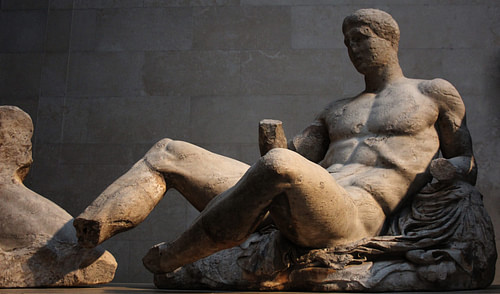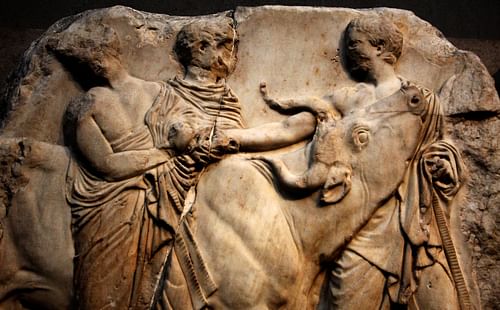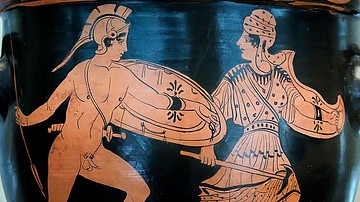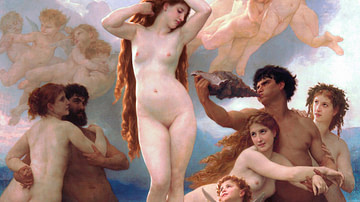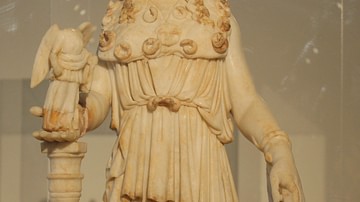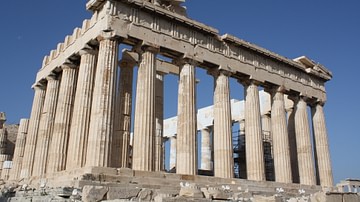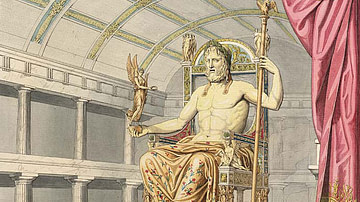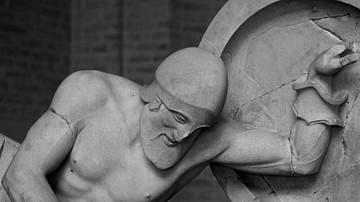The extraordinary quality and quantity of the marble sculpture which adorned the 5th century BCE Parthenon in Athens made it the most richly decorated of all Greek temples. The sculpture, now mostly separated into the Parthenon Marbles (Elgin Marbles) and the Acropolis Museum Collection of Athens, once consisted of 92 metopes, a unique frieze running around all four sides of the building, and both pediments filled with 50 monumental figures. The sculpture presented scenes from mythology which were a metaphor for the Greek triumph over Darius and Xerxes in the recent Persian Wars. The whole edifice and fine artwork were designed to wow onlookers and glorify Athens and her patron goddess Athena. As the instigator of the whole project, Pericles rightly boasted "...we shall be the marvel of the present day and of ages yet to come".
The Parthenon
Built between 447 and 432 BCE, the Parthenon was dedicated to Athena, the patron deity of Athens, and contained a huge twelve metre high cult statue of the goddess made of wood, ivory, and a whopping 1,140 kilos of gold. Constructed in the golden age of Pericles, the massive temple measures around 31 x 70 metres and was a celebration of the Greek triumph over the invading armies of Persia. It was designed by the architects Iktinos and Kallikratis to proclaim to the world the glory of Athens, and for this reason its exterior was embellished with some of the finest architectural sculpture ever to be produced in antiquity.
Pentelic marble, 22,000 tons of it, was taken from nearby Mt. Pentelicus and used in the construction, as it was appreciated for its pure white appearance and fine grain. Traces of iron in the marble have, over time, given the stone a soft honey colour which is particularly evident at sunrise and sunset.
The decorative sculpture was supervised by the master sculptor Pheidias, who was also responsible for the giant statue of Athena which stood inside the temple. That different sculptors worked on different pieces is evidenced by the varying quality of the sculpting and the sheer volume of work required. This was also, no doubt, a necessity due to the short time-frame for the construction. Never before had a Greek temple been so richly decorated. The main theme of the sculpture was the fight between order and chaos, a metaphor for the wars between Greeks and the Persian enemy they considered "barbarians". Much of the sculpture has suffered damage of various sorts over the centuries, but with the aid of descriptions by Pausanius of the 2nd century CE and drawings made by a Flemish artist (perhaps Jacques Carrey) in 1674 CE, some of the more seriously damaged pieces may be tentatively identified.

The Pediments
Pediments present the sculptor with the challenge of filling a triangular space, and in this case a large one of 28.55 metres long with a maximum height of 3.45 metre in the centre. Fifty outstandingly rendered figures decorated the pediments (but only eleven survive). These were sculpted in the round despite the fact that the back would not be seen from ground level, 16 metres below. In addition, the ends of the pediments had a lion-head sima or gutter (in this case false), one of which, from the north-east corner, survives.
To solve the problem of diminishing space in the corners, the sculptors had figures reclining near the ends or dissolving into an imaginary sea or even had the sculpture overhang the lower edge of the pediment. The east pediment depicted the birth of Athena (which connects nicely with the frieze's depiction of the Panathenaic Festival held on the goddess' birthday), whilst the west pediment showed the competition between Athena and Poseidon to become the patron of Athens, the former offering the Athenians a salty spring, the latter the first olive tree. This was another unusual feature - to have the deity of the temple appear on both pediments.
The west pediment was dominated by the two gods Athena and Poseidon (each three metres tall) arguing over who should win the favour of the Athenians. What stood between them survives only in fragments but may have been either Zeus' thunderbolt or Athena's winning gift of the olive tree, possibly in bronze. Either side was a chariot with rearing horses, that closest to Poseidon probably carries his attendant Amphitrite, while on the left Athena's chariot is driven by Nike. Athena is also attended by Hermes, while Iris stands close to Poseidon. Then extending to the edges are various standing or seated figures, probably early Attic kings and heroes; the most certainly identified is Kekrops, portrayed with his conventional snake coils. Another easily identified figure is a sea monster representing the power of Poseidon to control the seas. The reclining figure on the far left side, whose leg disappears into the base of the pediment, has been identified as the river god Ilissos or Eridanos.
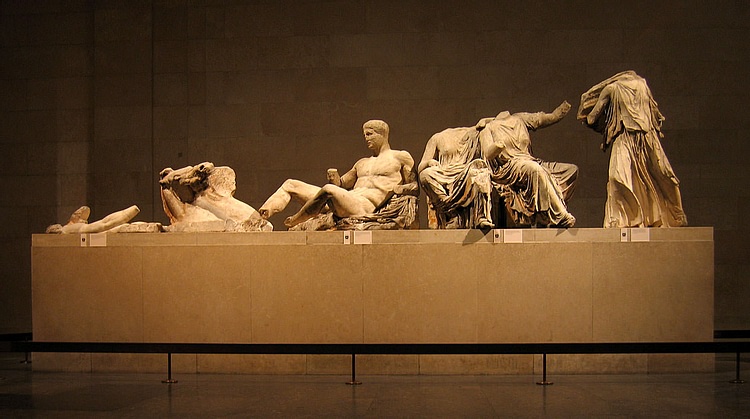
The central composition of the east pediment is more speculative due to the paucity of the surviving pieces and the loss of the bronze identifying attributes the figures would have held in their hands. Zeus is centre-stage with his daughter Athena, just born, standing immediately to the right fully armed. Next to Athena stands Hephaistos who assisted in the birth by splitting open Zeus' head with his axe. The other Olympian gods make up the rest of the pediment sculpture. Helios and the horses of his chariot spring from the left corner which represents the ocean Okeanos, which encircled the world. Next is Dionysos reclining on his panther skin (the best preserved figure but possibly also identified as Hercules on a lion-skin, even if his early presence would be incongruous at the birth of Athena), next could be Demeter and Kore (or Persephone) sitting on wooden chests, then Artemis (or Hebe) who seems about to step out of the pediment as she leans forward. Hera and Apollo may have stood to the left of Zeus. On the right side, after Poseidon's chariot, are probably Hestia, Dione, and Aphrodite who reclines on her mother's lap and may be identified by her robe seductively leaving one shoulder bare. In the far right corner may have been Selene (the Moon) or Nyx (Night) with the horse heads of her chariot team filling the right corner, mirroring those of Helios on the opposite side. The horses of Helios, though, are depicted full of energy as they begin their daily journey across the sky, while Selene's horses look exhausted, as they are at the end of their daily run and sink back into Okeanos. This signifies that the whole scene must be at dawn.
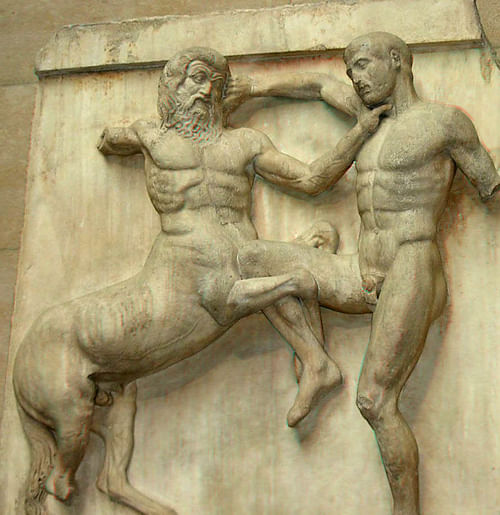
The Metopes
The Parthenon is again exceptional in that all the metopes were filled. The 92 metopes were carved in high relief (up to 25 cm in depth and almost in the round), and each slab measures around 1.25 x 1.2 metres. Thirty-two metopes, alternating with triglyphs, were placed along the long sides of the building, while each façade had 14. All the backgrounds were originally painted red.
The most important metopes were on the east side, as this was the principal entrance to the temple. Here the Olympian gods fight giants for control of the universe; four scenes show chariots but some of the gods remain unidentified due to their damaged condition. The west metopes depict Greeks fighting Amazons, the latter being another metaphor for foreigners and, as such, they wear oriental hats and costume. The figures are so badly damaged that it is impossible to be certain the figures are female, but the alternative, that they are Persian soldiers, seems unlikely given the mythological subjects of the rest of the sculpture on the Parthenon. The Greeks are semi-nude, and probably the hero Theseus is included in the narrative while the Amazons ride horses or fight on foot. Each metope portrays a one-on-one duel with sometimes the Amazons winning, sometimes the Greeks.
The north metopes show the fall of Troy - once again taken as a metaphor for Persia, an established convention in Attic art - with the first three (from the western end) showing deities seemingly in judgement of the proceedings, including Athena descending from her chariot. Other scenes include warriors leaving their ship, Odysseus searching for Helen, Menelaos meeting Helen, and the escape of Aeneas. The south metopes depict Greeks fighting centaurs, another metaphor for chaos and barbarism, possibly at the wedding of Perithous, the king of the Lapiths, when the centaurs became drunk and attempted to abduct the Lapith women. Theseus, the king of Athens, was one of the guests at the wedding, hence the connection with the city. They would have originally had bronze additions such as weapons; nevertheless, these metopes, nearer the steep sides of the acropolis, are amongst the best preserved of the Parthenon's sculptures, and they show a vibrant, dynamic struggle between the protagonists.
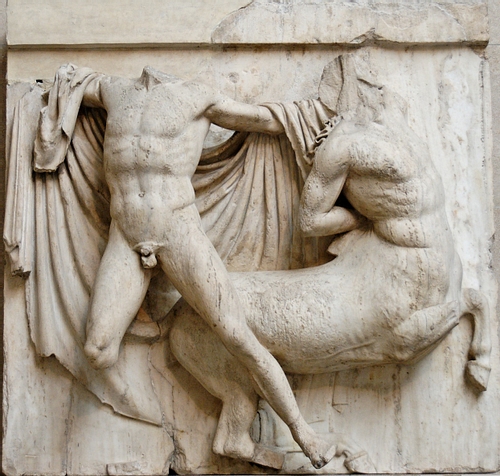
The Frieze
The frieze measures 160 metres in length, is almost one metre high, and includes an astonishing 380 figures and 220 animals, mostly horses, all carved in low relief (maximum 6 cm) overlapping across 115 slabs. Through a combination of surviving pieces and drawings, 90% of the frieze can be reconstructed. Running around all four sides of the building between the outer colonnade and the inner cella, the narrative of the frieze begins in the south-west corner and then runs parallel down the long sides to conclude at the far end, exactly over the main doorway. Such a design was an Ionic feature and more typical of treasury buildings. However, in reality the Parthenon and the gold sheeting on the statue of Athena also served as the city's treasury and that of the Delian League. The frieze was unusual in that it did not depict scenes from Greek mythology and unique because all four sides depict a single subject - the Panathenaic Procession. This was a religious ceremony held every four years which involved a procession along the Sacred Way and finally delivered a new, specially woven robe or peplos, the arrhephoros, to the ancient olive-wood cult statue of Athena housed in the Erechtheion next door to the Parthenon.
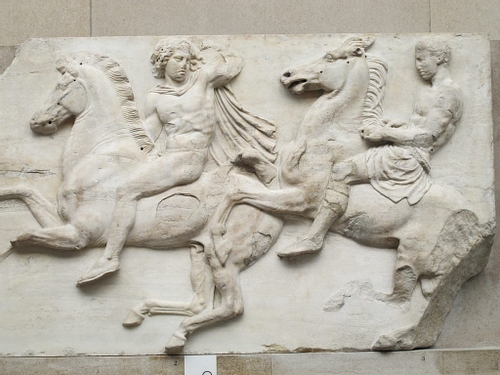
As the space is narrow in which to view the frieze, the background of the scenes was painted blue, figures were also brightly painted in blue, red, and gold, and the relief made deeper at the top so that the figures seem to lean towards the viewer far below. Some details were painted rather than sculpted, three-dimensional additions such as weapons and horse reigns were added in bronze, and eyes were rendered using coloured glass.
A cavalcade fills 70% of the composition, and the actual robe ceremony seems to be depicted in the centre-east portion. There are dignitaries, musicians playing the kithara and aulos, and horsemen variously portrayed naked or wearing tunics or armour and perhaps representing the heroes of Marathon but also perhaps athletes riding for sport; some also see the mythical founder of the Panathenaic Festival Theseus as one of the riders. Other figures in the procession include marshals, elders or judges holding olive branches, charioteers (apobates who jump on and off their moving chariots whilst wearing full hoplite armour as in the sporting event of the festival games), sacrificial animals (rams and oxen), women carrying water-pots, bowls and loom stands, boys carrying trays of offerings, heroes, and the Olympian gods who seem to be in animated conversation as they await the arrival of the procession.
Athena and Zeus take centre-stage, and they are both rendered slightly larger than the other gods in the frieze. The twelve gods are seated on stools with a throne reserved only for Zeus, and they are attended by two lesser deities. From the left side is Hermes with his famous hat on his lap, next is Dionysos who rests his arm on Hermes' shoulder, then comes Demeter who holds the torch which she used to search the underworld for her abducted daughter Persephone, then come Ares, Iris, and Hera, who is raising her bridal veil, then, finally, Zeus on his throne. To the right side is Athena with her aegis on her lap, then Hephaistos with the stick he carried for his lameness. Then sit Poseidon whose trident was added in paint, Apollo, who would have worn a gilded wreath as indicated by the small holes in his hair, Artemis, Aphrodite and, finally, Eros holding a parasol.
In the centre, on the east side, is the climactic scene of five figures engaged in the ceremony involving the peplos. There are three children, two of which are certainly girls. The adult male is perhaps the senior archon, who receives the peplos, and the woman may be the priestess of Athena, who takes a stool from one of the girls.
Conclusion
The Parthenon remained in use for over 1,000 years, but when it was converted into a Christian church in the 5th century CE, much of the decorative sculpture was deliberately damaged or removed in an effort to wipe away the pagan past. In addition, the inclusion of an apse on the east side required the removal of part of the east frieze. In 1458 CE the occupying Turks converted the building into a mosque, and in 1687 CE it was used as a powder magazine. This proved disastrous when a shell from the attacking Venetians set off the powder and ripped the heart out of the building. The Venetian general Morosini then did further damage when he tried to remove figures from the west pediment, smashing the horses when his rigging tackle collapsed. It seemed that the great art of this once great monument was destined to be lost forever.
Left as a glorious ruin with looters and souvenir hunters freely taking mementos from the site, in 1801 CE the Earl of Elgin obtained permission from the indifferent Turkish authorities for the right to take casts of the remaining sculpture and remove any pieces he fancied. This collection, known as the Elgin Marbles or Parthenon Marbles, was bought by the British government in 1816 CE, to be finally displayed in the British Museum, London. A portion of the frieze, a metope, and a head from a pediment figure also reside in the Louvre, Paris and several more pieces are scattered around European museums. Some of those pieces left on the monument were not removed until the 1980s and 1990s CE and have consequently suffered severe damage from air pollution; they are now displayed in the Acropolis Museum a few hundred metres from the Parthenon and arranged exactly in the sequence as they were originally with casts for the missing pieces. The debate goes on to unify the sculptures in a single exhibition space, but wherever they are to be seen, the Parthenon sculptures continue to enthrall the visitor and capture both the admiration and imagination of all, no doubt just as they did 2,500 years ago.
